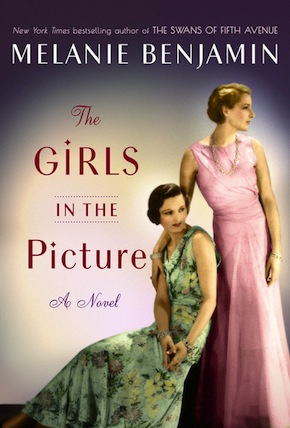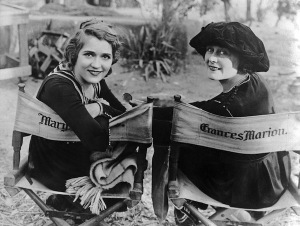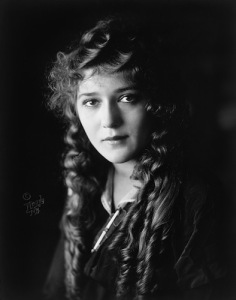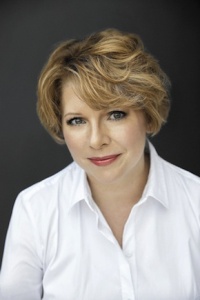Flickers of memory
by Melanie Benjamin
“A star-studded story of female friendships, creative sparks about to ignite, and the power of women. Dazzling.” Caroline Leavitt
Lately, the line between real life and movies has begun to blur.
There are times when I’m pounced upon by a memory – the cracked rearview mirror of the first car I ever owned, say, or the ghostly dance of a curtain in front of an open window when I was small and impressionable and plastered in bed with a fever. Or the teasing curve of a man’s lips, a man whose kiss I must have known at some time in my life. And the longer I dwell on the memory, the less certain I am of its origin. Is the memory really mine?
Or is it borrowed from a movie I’ve written? Was the curtain dancing because there was a fan off-camera, trained at precisely the right angle? Were the man’s lips curving as they came near mine, or were they moving closer to the camera lens instead?
More and more, I can’t always tell the difference. And I’m not quite sure how I feel about that, to tell the truth. On the one hand, it might be easier to live the rest of my days believing all my memories, particularly the bad, were invented for someone else to experience on screen.
On the other hand, if I can’t claim as my own the memory of Fred’s head always ending up on my pillow during the night, as if he simply couldn’t stand to be apart from me for even the span of his dreams, how on earth would I ever be able to fall asleep again?
And the number of people who might be able to place the memories firmly into either category – real or cinematic – is dwindling.
No, not ‘dwindling’, Fran. That’s a prissy word. Say what you mean. They’re dying. Your friends, your colleagues, all the Hollywood relics like yourself – dying off. Like old war horses put out to pasture; like plants that have hung around far too long in the florist’s window.
Even on those occasions when I knew that I was most certainly standing in front of a real house, one I had visited many times before, and that I was being cooled by an actual breeze and not studio fans, I couldn’t help but touch the rough stucco on the wall, just to make sure I couldn’t poke my finger through it. And so I did. Touch it. Then I rang the doorbell again.
“I’m sorry to have kept you waiting, Miss Marion.” A liveried butler opened the door, catching me as I poked at the stucco once more. He squinted at me cautiously, as if I really were the dotty old lady I must have seemed. “Miss Pickford is not receiving visitors today.”
“You told her it was me? Frances? That I asked for her? For Squeebee?”
“Yes, Miss Marion. Miss Pickford still says she is not receiving visitors today.”
“Is she – Is she ill?”
The butler looked down at his polished shoes and declined to answer.
I glanced at my watch and considered my options: Walk away, leave, and let the tragedy play itself out. After all, the last time I’d tried, I’d been insulted and thrown out of the house. That time, I’d vowed I’d never come back. Yet here I was. Trying to revise the tragedy one more time like a fool. A sentimental old fool.
Just a typical evening at Pickfair, the royal manor of Hollywood, where Mary Pickford and Douglas Fairbanks reigned supreme, Charlie Chaplin their unofficial court jester.”
Closing my eyes, I pictured my small apartment, the cool, tiled floors, the plush embrace of my sofa, a nice tall glass of iced tea at hand, maybe dozing to the comforting chatter of The Edge of Night or another of my soap operas. Because I really was too ancient for this, this arduous, thankless business of saving.
And where had Mary been, when I needed saving, so long ago? Here, as a matter of fact. Hiding behind this very closed door. So why was I knocking on it now?

Mary Pickford and Frances Marion on the set of The Love Light (1921). Mary Pickford Company / United Artists / Wikimedia Commons
Shared memories; triumphs and tragedies; the heroine doing right in the end despite temptation – all the plots of all the movies I’ve written tangled together into one gigantic ball of yarn I couldn’t begin to unravel. Finally, I tugged on the loosest, biggest thread.
Because time is running out.
I squared my shoulders, sucked in my stomach, and pushed past the startled butler until I was inside the cool front hall of Pickfair. “Where is Buddy – Mr Rogers?”
“Mr Rogers is attending a luncheon. He should be back momentarily.”
“Let me go up to her. Do you know how many times I’ve been in this house? How many times I’ve held her hand and told her everything would be all right? No, of course you don’t, you’re too young, you’re an embryo and I’m a dinosaur, I know. Well, young man, let me tell you – plenty of times!”
The young man, sporting the usual Hollywood tan, paled anyway. Sucking in his breath, he showed his enviable cheekbones to their best advantage, daring to give me a glimpse of a blindingly white, perfect smile. I nearly laughed out loud. Of course! The Pickfair butler was exactly like all the other poor undiscovered souls in Hollywood, biding time until his big break. Oh, how some things never changed.
“I know Sam Goldwyn, young man. He’s a personal friend of mine. If you want…”
“Of course, Miss Marion, go right on up!”
I bit the inside of my cheek as I started across the hall. “And if you’d like,” the young man called out in a suddenly rich, resonant baritone, “I’ll give you my headshot when you leave!”
I had to chuckle. Poor boy. He had no idea that Sam Goldwyn was even older than I was, and mad as a hatter, at that.
Shifting my handbag to my other arm, I set off across the slick, polished floor of the front hall, certain that I would not slip or falter, even though I had seen many people do that in the past. Charlie Chaplin once tied some of Mary’s monogrammed dinner napkins to his shoes and skated across this floor, re-enacting one of his scenes from The Rink.
Mary had looked on with an indulgent smile – the same tight, practiced smile she granted Chaplin in all the photographs and newsreels – but she’d been furious, all the same. I could tell by the way my friend’s determined chin seemed more determined than ever, rigid with forced cheer. Doug, of course, had not only egged Charlie on, but then had to top him by tying napkins to his shoes, and lifting Chaplin onto his shoulders and twirling him around and around, finally throwing the smaller man into the air and catching him, to the delight of the assembled guests.
The Duke of Alba had been there that night. Along with Gloria Swanson, Rudolph Valentino, Vilma Banky and Aimee Semple McPherson. Just a typical evening at Pickfair, the royal manor of Hollywood, where Mary Pickford and Douglas Fairbanks reigned supreme, Charlie Chaplin their unofficial court jester.
Of course, I’d always attended when invited – or rather, summoned – but I wasn’t fond of those formal evenings, when Mary and Doug sat side-by-side at an enormous table groaning with fingerbowls and several different forks. Try as I might – and risking Doug’s wrath – I never could hide my amusement at these actors and actresses elevated to deities simply because of their looks; troupers with whom I’d once shared stale cheese sandwiches and glasses of beer who suddenly wrinkled their elegant noses if a servant happened to spill a drop of champagne. “The help,” they’d whisper scornfully, these gods and goddesses who had once been maids or gardeners themselves, and we all knew that it was only because of a fluke, a genetic lottery won or a benevolent mogul slept with, that they now wore tiaras and aped the regal characters they played on the screen. The characters I wrote for them.
They took themselves so seriously back then, these newly-christened movie stars, still too unsure if the fledgling industry in which they worked – that we all had actually created with pluck and luck – would endure to be able to mock it, and none more than Mary Pickford. Sometimes I would gaze at her, draped in diamonds, her golden curls piled upon her head so that her sapphire earrings could be more easily admired as she nodded regally and conversed with true royalty, and I couldn’t believe my eyes. How had this happened? How had a fatherless little Irish girl from Canada come to dine with kings and queens?
Mary once confessed to me that her face felt odd, cold, when not bathed by arc lights and baby spots; the heat of the studio lights had become so familiar, actual daylight seemed dim by comparison.”
And how had a twice-divorced bohemian from San Francisco come to be one of her honored guests? I had to lump myself in with all the rest; my own journey had been no less fantastic. I went toe-to-toe with Louis B. Mayer and William Randolph Hearst. I was the highest-paid screenwriter in the industry. And I, too, had ‘gone Hollywood’.
At least, until Fred died. Then I came crashing down to earth, and the tiaras and mansions seemed flimsier than movie sets and props, the only tangibles the emptiness in my bed at night, the silence that answered my whispered questions when I was alone with only my typewriter for company.

Mary Pickford publicity portrait, c. 1915. Rufus Porter Moody / Library of Congress / Wikimedia Commons
Still, I counted myself among the fortunate ones in this cruel paradise. Every night I thanked my lucky stars for my life, tragedies and all, because they had forced me to take a different path, one not blessed and cursed with a grand, winding staircase like the one I was now ascending, the chandeliers blazing like a thousand stars, the velvet draperies exquisitely embroidered but designed to keep real life firmly at bay.
Slowly climbing – Good Lord, had these steps always been so steep? – I glanced into the famous drawing room off the entrance hall. There, over the fireplace, hung the iconic portrait of Mary Pickford, the Girl with the Curls, captured forever in the full flower of her youth and beauty, the face that, at one time, had been worshipped and adored by everyone in America – including me.
That portrait. That idealized little girl. She was the reason Mary was currently hiding in a dark room, afraid of the sunshine, afraid of a light unforgiving, unfiltered; that same light that had so loved and flattered her when she was young. Mary once confessed to me that her face felt odd, cold, when not bathed by arc lights and baby spots; the heat of the studio lights had become so familiar, actual daylight seemed dim by comparison.
Now, if the gossip was to be believed, Mary Pickford emerged only at night, sometimes standing in front of her portrait, staring up at it. Sometimes playing with her fabled doll collection, down on her knees, arranging Lilliputian tea parties or tenderly changing infant-sized clothes.
“I ought to pull that damn portrait down with my bare hands,” I declared, not caring who heard. I talk to myself all the time; I consider it one of the perks of old age.
Finally I reached the second floor, my limbs trembling from the exertion, my blouse stuck to my clammy skin. For a moment I couldn’t catch my breath; the stagnant air seemed to wrap my chest in a vise. Oh, for the days when I had tagged along effortlessly after Mary as she jumped nimbly about the set, playing pranks, the two of us giggling like little girls as we made our movies together.
Eighty. I was now eighty. Even Chaplin had started to slow down in his seventies. I took one more deep breath, smoothed the front of my blouse, felt my damp forehead, then continued down the carpeted hallway lined with more portraits and photographs of Mary – Mary in Pollyanna, in The Poor Little Rich Girl, in Little Annie Rooney, in Little Lord Fauntleroy. Photographs of Douglas Fairbanks in costume, his white teeth gleaming in his tanned face, his eyes crinkled with dashing merriment.
No photographs of Buddy Rogers, however. For the hundredth time, I wondered how Mary’s current husband put up with the ever-present image of his predecessor. She sometimes called him ‘Douglas’. And Buddy always answered with an eager smile that made me slightly ill.
Finally I reached the end of the hall, where I confronted a closed door. I hesitated for a moment – a moment long enough for me to stoke my anger and resentment and remember all the times Mary had not been there for me. A moment long enough to consider turning back one last time. Then in another one of those memories that might have been a movie, I heard myself saying, long ago and in vastly different circumstances but with the same amount of false bravado, “I’ve never turned back in my life.”
So I knocked firmly on the door, loud enough to banish the memories and ghosts so that I might have at least a passing chance of saving the living.
“Mary? Mary, it’s me. It’s Frances. Why haven’t you returned my calls?”
“No!” That rusty voice, so unused now it really did sound like a little girl’s, high-pitched, uncertain, quavering. “No, go away, Fran, dear. I’ll call you tomorrow.”
“I’m coming in, Mary. I want to talk to you. Right now.”
“No! I’m not – Squeebee’s not vewy well today, Fwan!”
Grimacing at the baby talk, I grabbed the door handle. “You’re perfectly fine.”
Pushing open the door, I had to pause when I crossed the threshold. The room was so dark, my hands shot out instinctively to feel my way, as if I were blind. Only the smallest sliver of light had managed to penetrate the tightly drawn curtains and in here, there was dust; particles drifted and danced through the weak sunrays. There was also a familiar odor: the sharp, sweet smell of whiskey and the juniper scent of gin.
Finally, I made out the enormous bed with its draped headboard. A tiny figure was propped up against the pillows – only a shadow, really. It took a long minute for the detailed image to emerge from the gloom. When it did, my heart twisted first with horror, then with pity. I took a step backward, retreating into the safe embrace of another memory, a memory I hadn’t managed to banish, after all.
A memory of a different time, a different door, the same tiny figure emerging from the gloom of a darkened room.
Excerpted from The Girls in the Picture © 2018 by Melanie Benjamin by permission of Delacorte Press, a division of Random House, Inc. All rights reserved. No part of this excerpt may be reproduced or reprinted without permission in writing from the publisher.
 Melanie Benjamin is the New York Times bestselling author of The Aviator’s Wife, The Autobiography of Mrs Tom Thumb, and Alice I Have Been. Her novels have been translated in over fifteen languages, featured in magazines such as Good Housekeeping, People and Entertainment Weekly, and optioned for film. She lives in Chicago. The Girls in the Picture is out now from Delacorte Press/Bantam Dell.
Melanie Benjamin is the New York Times bestselling author of The Aviator’s Wife, The Autobiography of Mrs Tom Thumb, and Alice I Have Been. Her novels have been translated in over fifteen languages, featured in magazines such as Good Housekeeping, People and Entertainment Weekly, and optioned for film. She lives in Chicago. The Girls in the Picture is out now from Delacorte Press/Bantam Dell.
Read more
melaniebenjamin.com
@MelanieBen
Author portrait © Deborah Feingold

